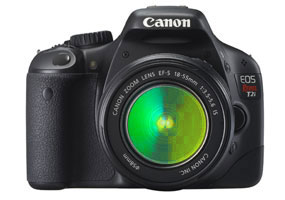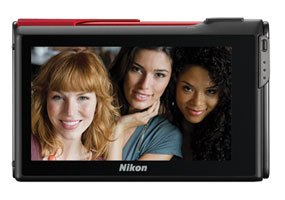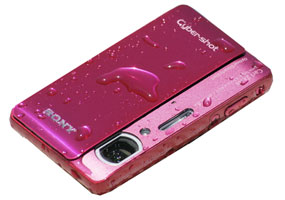Quest for the Green Camera
Millions of digital cameras are sold each year in the U.S. And, generally speaking, the ascent of the digital camera is seen as an environmental step up; they eliminate the need for film and toxic film processing, and they prevent you from printing pictures you don’t want or need. But a lot goes into the creation of a digital camera, and it’s in the manufacturing—and shipping, and discarding—that a camera’s true environmental impact is made plain. Buyers can check, for example, whether a camera is in compliance with the Restriction of Hazardous Substances directive (RoHS), which bans certain materials from electronics in the European Union, including lead, mercury, cadmium and flame retardants known as polybrominated diphenyl ethers, or PBDEs.
It’s also worth considering how a camera is powered. The “greenest” cameras will come equipped with rechargeable batteries, an energy-efficient charger and recycled or greatly reduced packaging. And the final determination comes not from the camera, but the environmental commitments of the company that makes it. Here are E’s top picks for digital cameras—and companies—that make good on their commitments.

CANON – Through the Clean Earth Campaign, Canon has been proactive in providing a voluntary recycling program for used ink cartridges from photo printers. Each printer cartridge comes with a UPS label, and can be shipped back to the company—which picks up the shipping cost—to be turned into a new cartridge. Beyond that, the company reports that its emissions were reduced by 41% from 2008 to 2009, to 888,000 tons. The company’s EOS Rebel T2i digital camera ($900) fulfills the EU standards, coming equipped with a lead-free lens (it uses titanium or barium instead) and lead- and cadmium-free insulating materials in the cables. Lead-free solder like tin, silver or copper is used during production as well. All of which will make you feel much more at ease when zooming in for crystal clear 18-megapixel shots or shooting HD video with optional stereo sound. www.canon.com/environment

NIKON – There’s a long list of environmental criteria on which Nikon is trying to improve, from energy efficiency, to minimizing resources, to reducing hazardous chemicals. The company assesses the lifecycle of their products on a scale of -100 to +100 and so far are scoring 52 points. They’re discontinuing hazardous chemicals like mercury, cadmium, and polyvinyl chloride (PVC) entirely, and have established programs for collecting and recycling batteries used in digital cameras in Japan. They also collect and recycle many used electronic products—including cameras—in 25 countries in Europe. Unfortunately, the U.S. does not have a requirement similar to the EU’s Waste Electrical and Electronic Equipment Directive.The latest CoolPix S80 ($330) camera boasts increased energy efficiency for longer battery life, meaning you can take up to 150 images or a little over an hour of movies before recharging. It has 14.1 megapixels for super-sharp images, a “smile timer” that releases the shutter when a subject smiles and takes two sequential shots automatically, saving the one where a subject’s eyes are open. www.nikon.com/about/csr/index.htm

OLYMPUS – “The Olympus Group regards global warming as a life-threatening problem that could not only have a devastating impact on human communities, but also cause major impacts in the natural world,” the company writes on its website. Their goal is a 50% reduction in carbon dioxide emissions across product lifecycles by 2020, compared with the 2007 level. Olympus certifies their own “Eco-Products” with a green leaf that indicates reduced use of chemicals, energy conservation, recyclability in design and data disclosure.Over 200 products have earned a leaf, including the FE-47 ($110), which can be tucked into a pocket, but still provides five-time optical zoom with “Advanced Face Detection.” It’s free of hazardous substances like PVC, lead and cadmium, and its low price and AA batteries (use rechargeable) make this a good basic family camera. www.olympusamerica.com/environment

SONY – With its “Road to Zero” campaign, Sony is aiming for an environmental footprint of zero for the lifecycle of its products and business activities by 2050. Midterm targets—including 30% reduction in energy consumption of projects compared to 2008, 10% reduction in weight, 50% reduction in waste generation compared to 2000 and an increase of a waste recycling ration to 99% or more—are to be implemented this year. In the U.S., Sony was the first to offer a national Take Back Recycling Program, where consumers can recycle any Sony product for free. So far, the company has recycled more than 13,000 tons of electronic waste.Sony’s Cyber-shot TX5 digital camera ($330) has a lot to offer. The lithium-ion battery allows you to take 125 minutes of footage or 250 images for starters. The 10.2 megapixel camera also features a 3-inch wide LCD touch screen for easy menu selection, a panorama mode, high-speed 10-frame-per-second shooting, HD movie mode, and it’s also shatterproof, shockproof, dustproof, freeze-proof and waterproof up to depths of 10 feet. Or, as Sony says, “adventure proof.” www.sony.net/SonyInfo/csr/eco/RoadToZero

